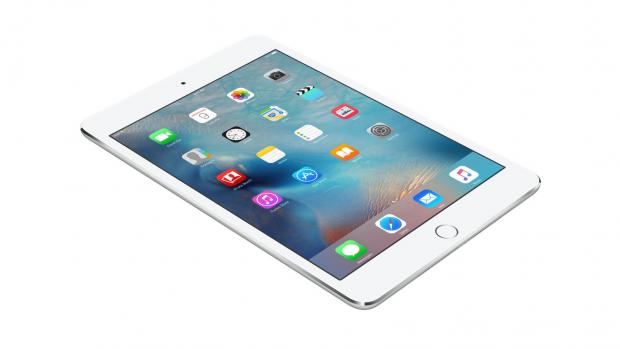Screen Test on Ipad Mini 4 – Applerepo.com, With iPad Mini 4 were promised better color reproduction and it is true. Compared with the iPad Mini 3 the difference is huge where the fourth version is better in every way and more color accurate. Older Mini models lack the range for red hues and therefore gave pale skin colors which also means that the monitor is not capable of deep red and blue hues. Thus is also magenta, pink and purple tones totally wrong of iPad Mini 3. At first glance, the Mini 4 to see much more colorful like compared to the Mini 3, and that the impression should you trust. Mini 4 gives the right colors. Mini 3 do not give the right colors.
Maximum brightness of the iPad Mini 4 is just over 400 cd / m2 similar to previous iPad models. Minimum brightness is just under 5 cd / m2 which should be low enough for bedtime reading in the dark. The screen is color-wise stable throughout this range. The weaker it shines the less bluish white balance, around 6800 Kelvin instead of 7000 Kelvin color temperature. There is a small difference that can absolutely be measured but which are not directly visible, much less disruptive. You can depend on the colors of the screen no matter how bright you are driving. Again, it is similar to existing larger iPad models.
The ability to climb down the brightness to 5 cd / m2 is also an important difference of the apple ipad mini 4 from the ipad Mini 3, which contented itself with around 8 cd / m2 at the lowest brightness. It is still quite bright for a reading under the covers or equivalent. Now learn most run with automatic brightness active in any case, but it may be worth to know that in case you set the slider halfway through the scale, we reach about 160 cd / m2.
iPad Mini is now similar to other iPad models

IPad Mini 4 is, on the whole, therefore more similar to other iPad models. Compared with the iPad Air 2 is about the same in terms of color reproduction. Both draw something much against blue white balance, and it almost seems to be a little informal “Apple-standard” to aim for 7000 Kelvin, rather than the 6500 Kelvin as the normal white point is located on. Thankfully keep current iPad models balance of red and green and we will no longer see color cast to turquoise or pink. It is slightly blue, but no more.
We step into the color space and measures the iPad Mini 4 sets nuances, it is clear that the slightly blue white balance is the biggest problem. Though the problem is still small in terms of the big picture. When we measure the representation of the standard (and classic) Color Checker colors are the average level of error for 2 (dE2000) which is about the best you can get in other contexts through color calibration.
Even such details as tone curve / gamma are better at Mini 4 with a little clearer drawing of the darkest shades. The difference is not large, but in terms of precision, the Mini 4 slightly better than Air 2.Catchlight filter of the Mini 4 also reminds Air 2 in how it handles the room’s light. The blackness of the angle becomes purple in both models.
Ipad Air 2, by contrast, is still a force in that its panel shuts down its own light better. The contrast ratio of the iPad Mini 4 is about 950: 1 and an improvement on the Mini 3. Air 2 reaches rather a contrast ratio of 1100: 1 and set to the same brightness will then Air 2 to dig deeper into the blackness. This can be an advantage, especially when using the device in the dark and thus can more easily see how the blackness appears as a dark gray background rather than black. There, Air 2, the better the screen.
Now lack sophisticated control or ability to get more precision with iPad (and iPhone). You get the light you get, so to speak. Therefore it is good that the light coming anyway is so good that in other contexts would be classified correctly. Trained eyes can see that the white balance is slightly blue, but that is all. You can pick an iPad out of the box and basically trust that what you see is correct colors. Something that is not all that common in other contexts.
Check Out These Too:
- iPad Screen Shaking Issue iPad Screen Shaking Issue - There are different ways on how your iPad’s screen could shake. It could look like you are doing a lot of touches and tapping. Some…
- The Impossible Test iPhone Answers Impossible Test iPhone Answers. Want to take the impossible iPhone test? Well, if you do and you don't know how to get it on your phone, first download it here.…
- Best Free Drawing App for Ipad Best Free Drawing App for Ipad - The iPad has revolutionized how we create. We’ve gone from paper and pencils to digital screens. But, as great as being a digital…
- Apple to make Mini iPhone 5 A new rumour has emerged about Apple today and that is regarding the iPhone device. It is thought that Apple will actually be releasing a version of the iPhone later…
- Songify by Smule App for iPhone, Ipad and iPod Touch Songify is an iPod Touch application that has been released into the app store following the success of the Songify videos on YouTube, Songify basically is an app that will…
- Apple iPad 2 to have three different models There have been a lot of rumours about the Apple iPad 2 device that is set for release in the early part of 2011 and as the event where Apple…
- 3D Pool Master Pro for iPod Touch Who doesn't love to shoot a good game of pool every now and then? Or all the time at the local sports bar? Whether you're a rookie or a novice,…
- Apple iPhone 5 Release Date Rumours Continue The Apple iPhone 5 is expected to be released within the next couple of days following the array of online rumours and now, it is claimed that the device will…
- What Makes the iPhone and the iPod Touch Such… Part of what makes this electronics so popular and everyone wants to have them is because of all the things that can be done with them. There are the applications…
- How to Do Split Screen on iPad How to Do Split Screen on iPad - The iPad is a versatile device that lets you do a lot of different things. One of the features that people love…
- iPhone and iPod Touch Personal Safety Tips Here are some iPod Touch Personal Safety Tips ideas to safeguard yourself and your iPod or any small hand held gadget/phone. 1) Many peoples wear their iPods and iPhones in…
- Do You Know that You Can install Fortnite for iPhone… Do You Know that You Can install Fortnite for iPhone and iPad? - For you that do not know yet fortnite game could be installed on iphone or ipad, then…
- Traffic Rush iTunes Game for iPhone, iPod Touch and ipad Traffic Rush iTunes Game for iPhone, iPod Touch and ipad. Traffic Rush is one of the Top Free iPhone game App in ios apps store. Traffic Rush is a simple…
- Report: Apple Partner With Samsung For AMOLED… A Korean paper is claiming that Apple and Samsung will partner up just to bring the latest Active-Matrix Organic Light-Emitting Diode (AMOLED) display technology to the iPad 3. According to…
- AppStart iPad App Review One of the most difficult things that you will have to think about when you first get an iPad is the apps that you are going to download for it.…
- Kindle App for iPad So have you just gotten your brand new iPad and are loving all of the e-books that it lets you download and read with just a few swipes of your…
- Apple’s Steve Jobs Launches’ iPad 2 It has been rumoured for a while that the iPad 2 will be released by Apple at some point this year and yesterday, Apple made that rumour come true. During…
- iPad 3 to Include Quad Core CPU and 4G The iPad 3 is going to be Apple’s next big thing, we all know that, what we don’t know is what exactly the iPad 3 is going to include hardware…
- Download Area 51 Defense Free iPad Game Area 51 Defence is a free ipad game that has recently been released for the iPod touch and iPhone devices and has made its way to being one of the…
- Make a Trip to an Underwater World with Promini iPod… Promini iPod Touch Game. What are you doing right now? Need some assistance in spending time in a fun way? Here's a hint! You can play Promini iPod Touch Game…
- Download Snake Game App for iPhone, iPad and iPod Touch Download Snake Game App for iPhone, iPad and iPod Touch. Snake is a game that is certainly not new to the Apple iPhone and iPod Touch devices and it has…
- Flash Player for iPad Flash Player for iPad We all know that Apple does not allow Flash player for iPad, iPhone or iPod Touch. However, there is a way to get Flash on the…
- iPhone Nano makes its appearance again among rumors After a period of rumors about a supposed new iPad Mini and iPhone 5 we are coming back to a product less likely to be produced comparing to the 2…
- How to Fix a Cracked iPad Screen? How to Fix a Cracked iPad Screen? - AppleRepo.com, The most common issue to an iPad is the screen getting cracked, shattered or broken. Apple’s iPad aren’t cheap that can…
- Four Popular IPhone 4 Cases Get Reviewed Popular iPhone 4 cases. You are the proud owner of the new iPhone 4, but you are needing a case to fix that antenna problem. The front and back are…
- Mac Mini SSD Upgrade: A Complete Guide to Boosting… Can I Upgrade My Mac Mini Storage on My M4? One of the most common questions users ask is, "Can I upgrade my Mac mini storage on my M4?" Unfortunately,…
- Pizza Hut iTunes App - A Must Have iPad App for Pizza Lover If you remember 4 year ago in 2009, Pizza Hut was launching their first Pizza Hut iPhone app, which was quickly receive a few awards, as well as the heart…
- Apple See’s Huge Profits but Shares Fall Apple, the company behind many popular electronic devices including the iPhone and the iPod Touch devices has seen a huge boost in profits. The company posted their results for the…
- Top 3 Errors You Have to Deal With When Installing… Usually, installing a configuration profile on an iPad or iPhone with iPhone Configuration Utility is straightforward--but as at any time software meets hardware, errors can occur. Here are three errors…
- Rumors are the Apple is set to Release a Bunch of… Apple wasn't happy enough with the release of the iPad early this year, with the release of the iPhone 4 not much later in June. Now they've stirred up rumors…


